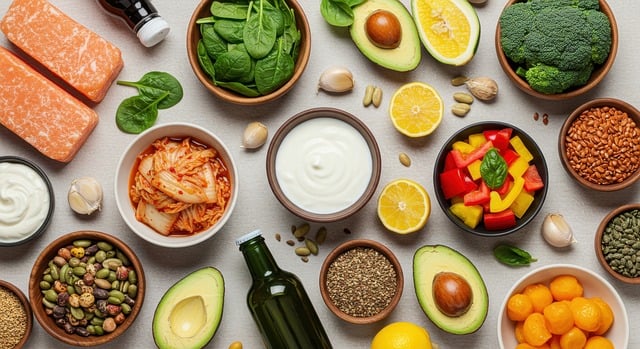Why Balance Matters
A balanced diet isn’t about eating perfectly—it’s about getting the right mix of nutrients your body needs to function and thrive. In plain terms, it means you’re not leaning too hard on one food group while ignoring another. Veggies, fruits, whole grains, proteins, and healthy fats all play their part. Skip one too often, and you’ll notice, even if it takes a while.
Daily nutrition lays the groundwork for long-term health. What you eat now shapes your energy, sleep, mood, immune strength, and even how you age. You’re not feeding just today—you’re fueling the years ahead. Bones, brain, skin, digestion—it’s all built, maintained, or broken down based on what’s on your plate.
Most nutrient imbalances don’t show up overnight. They creep in. Maybe it’s constant fatigue you chalk up to stress. Or skin issues that don’t quite make sense. Over time, skimping on key nutrients—like iron, vitamin D, or magnesium—can compound into real health concerns. And because modern diets often over-deliver on calories but under-deliver on quality, imbalance is more common than people realize. Awareness is step one. Action comes next.
The Core of Every Plate: Macronutrients
Carbs, proteins, and fats—nothing flashy, just essential. These three macronutrients do the heavy lifting in your diet. Carbohydrates are your body’s go-to fuel. They break down into glucose, which powers your brain and muscles. Think fruits, grains, legumes. Skip the myth that all carbs are bad. It’s the added sugars and ultra-refined stuff that trip people up.
Proteins are your repair crew. They rebuild muscle, support your immune system, and keep you feeling full. Lean meats, fish, eggs, tofu, and legumes are solid choices. If you’re working out or recovering, protein isn’t optional—it’s foundational.
Fats round out the trio. Despite the long-standing fear of them, fats are key for hormones, cell function, and nutrient absorption. You want the good ones—avocados, olive oil, nuts, seeds, oily fish. Avoid the industrial trans fats and greasy deep-fried junk.
So what’s the sweet spot? For most adults, a rough balance lands around 40–50% carbs, 20–30% fats, and 20–30% protein. But context matters—activity level, goals, and health conditions shift the formula. Where do people go wrong? Overloading fat and carbs together (think pizza, fries, ice cream) while protein takes a backseat.
Want to go deeper? Check out The Importance of Macronutrients in Your Daily Meals for more insights.
Don’t Sleep on Micronutrients
Macronutrients get all the spotlight, but without essential vitamins and minerals, your body doesn’t run well. Micronutrients are the behind-the-scenes crew—the ones that keep your system humming. They’re needed in small doses, but their impact is heavyweight. Think immunity, energy production, bone strength, even mood stability.
The modern diet, packed with processed foods, leaves a lot of people running on empty—especially when it comes to vitamin D, magnesium, iron, and B12. These deficiencies don’t always scream at you; they creep in. Constant fatigue? Foggy focus? Could be your micronutrient levels quietly tanking.
Whole foods are the first stop. Leafy greens, fatty fish, legumes, nuts—this is where real nutrition lives. But sometimes food alone doesn’t cut it, especially if you’ve got dietary restrictions, live in low-sunlight areas, or follow a plant-based diet. That’s when supplements can help—not as a shortcut, but as backup.
Bottom line: Don’t ignore the small stuff. Your body doesn’t.
Fiber, Hydration, and the Forgotten Essentials
Modern nutrition advice often overlooks simple yet powerful components of a balanced diet—fiber and hydration. These essentials support digestion, appetite regulation, and overall well-being, but they’re frequently misunderstood or underestimated.
The Power of Fiber
Fiber does more than keep things moving in your digestive system. It plays a key role in regulating hunger, stabilizing blood sugar, and supporting a healthy gut microbiome.
Why It Matters:
- Promotes satiety and reduces overeating
- Feeds beneficial gut bacteria, improving digestion and immune health
- Helps maintain stable energy levels throughout the day
Easy Ways to Boost Fiber Intake:
- Add chia or flaxseeds to your breakfast
- Swap white pasta and bread for whole-grain versions
- Load up on legumes, leafy greens, and raw vegetables
Hydration Beyond the Water Bottle
While water is essential, hydration doesn’t mean chugging liters all day. The goal is consistent intake from various sources.
Simple (and Sustainable) Hydration Hacks:
- Eat more water-rich foods like cucumber, melon, and spinach
- Infuse water with herbs or citrus for natural flavor
- Drink herbal teas or diluted electrolyte drinks if you’re active or sweating more
Skip the Sugar Trap:
- Sports drinks and juices often contain more sugar than necessary
- Don’t confuse fruit juice with hydration—it usually adds calories with limited benefit
Debunking Common Myths
Fiber and hydration are often marketed in misleading ways. Understanding the truth can help you make smarter choices.
Myth vs. Fact:
- Myth: Fiber bars are a reliable source of daily fiber
Fact: Many fiber bars are loaded with artificial ingredients and sweeteners, offering minimal real fiber
- Myth: Juice is a smart way to stay hydrated
Fact: Juice spikes blood sugar and doesn’t hydrate as effectively as whole fruits or water
Prioritizing real, whole food sources of fiber and making hydration a daily habit—not an afterthought—are simple steps that make a huge difference.
Portion Control Without Obsessing
Let’s be clear—you don’t need to weigh every almond or count the number of peas on your plate. Portion control doesn’t have to mean micromanaging your meals. A few simple tricks go a long way: use your hand as a guide (think palm-sized protein, cupped-hand carbs), serve meals on slightly smaller plates, and don’t eat straight from the bag—put snacks in a bowl. These aren’t hacks; they’re habits that create boundaries without making you feel boxed in.
Paying attention to hunger and fullness cues is also huge. Your body usually knows what it needs—you just have to listen. If you always clear your plate because it’s there, or you eat because you’re bored, stressed, or tired, you’re not actually responding to hunger. That’s where things get thrown off.
This is also why restrictive diets fall apart in the long term. Cutting out entire food groups or slashing calories might work for a few weeks, but your body fights back. Metabolism slows. Cravings rise. You start to feel burned out, not better. Sustainable balance comes from learning how to eat enough—not from constantly trying to eat less.
Bottom line: mindful portions and respecting hunger signals beat any crash diet on the market.
Practical Tips for Balanced Eating
Let’s keep this simple: every plate should have three things—protein, fiber-rich carbs, and a bit of healthy fat. Think grilled chicken with quinoa and roasted veggies. Or eggs, avocado, and a slice of whole grain toast. You don’t need to hit perfect macros every time, but if your meal looks like it came from the whole-food aisle, you’re on the right track.
When it comes to grocery shopping, resist the urge to buy everything you see on a wellness blog. Plan around a few versatile ingredients each week—things like leafy greens, rice, canned beans, frozen berries, and lean proteins. This keeps your meals fresh without wrecking your budget.
And here’s the part most people forget: perfection isn’t the goal. Use the 80/20 principle. Aim to eat well 80% of the time, and give yourself room for flexibility the other 20%. It’s how you stay consistent without burning out. Real balance means sustainable, not shiny.
Watch Out for These Pitfalls
Just because something has a health halo doesn’t mean it’s doing your body any favors. Plenty of so-called “healthy” foods are loaded with hidden sugars and sodium. Granola bars, flavored yogurts, and even veggie chips often sneak in added sweeteners or salt to boost flavor. These extras can add up fast—and quietly undo the good stuff you’re trying to eat.
The same goes for anything labeled “low-fat.” It might sound like a smart choice, but when manufacturers remove fat, they often toss in added sugar or starch to make up for the taste and texture. That means you’re not necessarily saving on calories—and you might be spiking your blood sugar in the process.
Bottom line: Read food labels like a detective. Skip the front-of-package marketing and flip straight to the nutrition facts and ingredient list. Look for short lists you can recognize and be wary of anything with five types of sugar hidden under different names. Real health comes from the fine print, not bold claims.
Final Thoughts
There’s no one-size-fits-all when it comes to nutrition. What feels like balance for one person might be too strict—or too loose—for someone else. Metabolism, lifestyle, preferences, and even culture play a role. The key is to build a way of eating that fits your real life, not someone else’s Instagram post.
Start small. That could mean drinking more water, adding greens once a day, or just cooking more at home. You don’t have to overhaul everything overnight. Step-by-step beats burnout every time.
Most of all, stop chasing hacks. The secret isn’t in some powder or a perfect meal plan—it’s in the habits you repeat. Eat whole foods more often than not. Pay attention to how you feel. Adjust when things feel off. Keep it simple, stay consistent, and you’ll get where you need to go.

 Thalira Tornhanna, the visionary founder of Food Smart Base, established the platform with a passion for transforming the way people engage with food. Guided by her dedication to health, innovation, and culinary education, she created a resource that not only delivers industry news and nutritional advice but also inspires better cooking practices and highlights emerging food trends. Through her leadership, Food Smart Base has become a trusted hub where readers can discover practical knowledge and fresh ideas that empower them to make smarter choices in their daily lives.
Thalira Tornhanna, the visionary founder of Food Smart Base, established the platform with a passion for transforming the way people engage with food. Guided by her dedication to health, innovation, and culinary education, she created a resource that not only delivers industry news and nutritional advice but also inspires better cooking practices and highlights emerging food trends. Through her leadership, Food Smart Base has become a trusted hub where readers can discover practical knowledge and fresh ideas that empower them to make smarter choices in their daily lives.